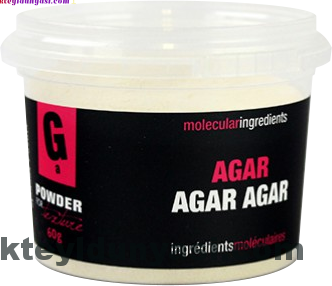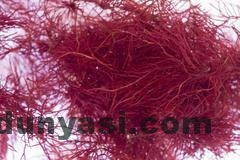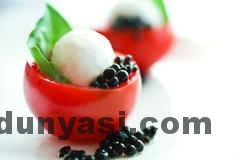
Agar Agar: A Culinary Marvel with Unique Gelling Capabilities

Function: Agar agar, derived from red algae, is a heat-resistant gelling molecule widely used in molecular gastronomy to create gel shapes like pearls, lentils, prisms, and spaghetti.
Origin: Belonging to the Gelidiaceae family, agar agar is extracted from red algae cell walls, specifically Gelidium and Gracilaria. It has a long history of use in traditional Asian cuisine. The term “agar agar” is of Malay-Indonesian origin, signifying jelly.
According to a Japanese legend, the agar agar production process was discovered in the mid-17th century. The owner of a small restaurant serving a meal made from Gelidium algae to Japanese soldiers would discard leftover jellies after the evening meal. These residues, freezing at night and melting and drying during the day, left a white residue in the garden within a few days. The restaurant owner collected these residues, reboiled them, and created a jelly with a whiter color and a different texture that the Japanese preferred even more. The production of agar agar continues to be purified through the freezing, melting, and drying method.
Properties: Agar agar is used for its unique gelling ability and the distinctive features of the resulting gels. Gelation occurs as solutions of agar-agar dissolve in pre-boiled liquids and cool. Depending on the properties of the algae used, gelation occurs between 32°C and 43°C.
In contrast to gelatin-based gels, agar agar gels retain their frozen state even at 85°C. The remarkable temperature difference between the gelation and melting temperatures makes agar agar molecules exceptional.
Agar agar does not impart any unique odor or flavor to the mixtures it is part of; instead, it enhances the impact of the flavors present. Due to the inevitability of gelation at concentrations lower than 1%, agar agar is used in extremely low doses. The freezing degree of agar agar is directly proportional to the amount used. Lower doses create a more fluid and delicate texture, while higher doses result in stronger and more brittle gels.
Industrial Applications: Due to its significant heat resistance, agar agar plays an indispensable role in enhancing stability and consistency in meringues and pie fillings. This characteristic provides flexibility in temperature control, playing a crucial role in the logistics of consumer foods.
Agar agar can be used as a stabilizer in sorbets and ice creams when combined with other plant gums. In yogurts and cream cheeses, it acts as a thickening agent. Its gelling property makes agar agar popular in fruit candies, especially in Asia.
Approximately 90% of agar agar production is allocated to the food industry, with the remaining 10% utilized in the health sector. Agar agar gel is used in laboratories worldwide to cultivate bacterial cultures in petri dishes. Additionally, agar agar is the main ingredient in dental impression pastes used by dentists.
Creative Culinary Uses: Agar agar is a staple in molecular gastronomy, utilized in creating various unconventional shapes and textures like pearls and gel spaghetti. Its simple technique involves melting agar agar in boiling liquid and then freezing. It is also used in nitrogen siphons to create light foams.
Agar agar-prepared presentations are heat-resistant, allowing the preparation of hot gels and foams.
Healthy Culinary Uses: Agar agar is completely calorie-free and consists of easily digestible fibers, constituting 80% of its composition.
Due to its ability to accelerate aroma dispersion and enhance fruit flavors, agar agar requires less sugar in jam-making, making it a preferred molecule over pectin. Moreover, agar agar serves as an ideal vegetarian alternative to animal-based gelatin.
Tips:
- Agar agar’s gelling property is activated by boiling the solution for approximately two minutes. After this process, keeping it at room temperature or in a cool place is sufficient to trigger gelling.
- For dissolution, it is recommended to use a hand blender to prevent clumps. Alternatively, a whisk can be used, but the crucial aspect is to add agar agar step by step and slowly into the liquid. Another technique is to dissolve agar agar in boiling water and add it to the prepared solution in the final step. Note that agar agar does not dissolve in solutions other than watery ones, so water must be added to enable dissolution in solutions containing fats or pure alcohol.
- Agar agar is an excellent substitute for animal gelatin. Just 2 grams of agar agar can replace the function of 3 sheets of animal gelatin (6 grams). Unlike gelatin, agar agar is entirely odorless and tasteless, making it preferable in some recipes. Additionally, agar agar captures the shape of the mold more strongly and retains its shape much longer than gelatin. Agar agar foams, being lighter and more porous, are preferred over a

Agar Agar: A Culinary Marvel with Unique Gelling Capabilities nimal gelatin foams.
- Agar agar requires careful consideration of the ratio between agar agar and liquid when attempting a recipe. Agar agar solutions only gel when cooled, so a small portion taken from the boiling mixture can be cooled at room temperature to assess gelation. Gelation takes approximately 3 minutes to complete. If the result appears too liquid, add a bit more agar agar to the solution; if gelation is overly thick, add a little more liquid to the solution.